Lakhmir Singh Biology Class 10 Solutions Life Processes
Lakhmir Singh Biology Class 10 Solutions Page No:23
Question 1:
Which is the basic requirement of living organisms for obtaining energy ?
Solution :
Food is the basic requirement of living organisms for obtaining energy.
Question 2:
Which of the following type of energy is used by living organisms to perform vital life processes ?
Kinetic energy, Chemical energy, Potential energy, Nuclear energy
Solution :
Chemical Energy.
Q
uestion 3:
Which of the following is an autotroph ? Green plant or Man
Solution :
Green Plant.
Question 4:
Name two inorganic substances which are used by autotrophs to make food.
Solution :
Carbon dioxide and Water.
Question 5:
What is the mode of nutrition in fungi ?
Solution :
Saprotrophic.
Question 6:
Name one organism each having saprophytic, parasitic and holozoic modes of nutrition.
Solution :
Saprophytic – Fungi.Parasitic – Plasmodium.Holozoic – Human Beings.
Question 7:
Name the process by which plants make food.
Solution :
Photosynthesis.
Lakhmir Singh Biology Class 10 Solutions Page No:24
Question 8:
In addition to carbon dioxide and water, state two other conditions necessary for the process of photosynthesis to take place.
Solution :
Sunlight and chlorophyll.
Question 9:
Apart from sunlight and chlorophyll, what other things are required to make food by photosynthesis ?
Solution :
Carbon dioxide and water.
Question 10:
(a) Name a gas used in photosynthesis.
(b) Name a gas produced in photosynthesis.
Solution :
(a) Carbon dioxide.
(b) Oxygen.
Question 11:
The leaves of a plant first prepare food A by photosynthesis. Food A then gets converted into food What are A and B ?
Solution :
A is glucose and B is starch.
Question 12:
Which substance is used to remove chlorophyll from a green leaf during photosynthesis experiments ?
Solution :
Alcohol.
Question 13:
Why do we boil the leaf in alcohol when we are testing it for starch ?
Solution :
We boil the leaf in Alcohol to remove all its green pigment called chlorophyll.
Question 14:
(a) Name the pigment in leaves which absorbs sunlight energy.
(b) What is the colour of this pigment ?
Solution :
(a) Chlorophyll.
(b) Green.
Question 15:
Name the pigment which can absorb solar energy.
Solution :
Chlorophyll
Question 16:
Name the organelle of plant cells in which photosynthesis occurs.
Solution :
Chloroplast.
Question 17:
Apart from carbon dioxide and water, name four other raw materials which are needed by the plants.
Solution :
Nitrogen, phosphorus, iron and magnesium.
Question 18:
Where is chlorophyll mainly present in a plant ?
Solution :
Leaves.
Question 19:
What is the name of those cells in the leaf of a plant which control the opening and closing of stomata?
Solution :
Guard cells.
Question 20:
Name an animal whose process of obtaining food is called phagocytosis.
Solution :
Amoeba.
Question 21:
All the animals can be divided into three groups on the basis of their eating habits. Name the three groups.
Solution :
(i) Herbivores.
(ii) Carnivores.
(iii) Omnivores.
Question 22:
What is the scientific name of the animals which are :
(i) only meat eaters ?
(ii) only plant eaters ?
(iii) both, plant and meat eaters ?
Solution :
(i) Carnivores.
(ii) Herbivores.
(iii) Omnivores.
Question 23:
Name the green pigment present in the leaves of a plant.
Solution :
Chlorophyll.
Question 24:
Arrange the following processes involved in the nutrition in animals in the correct order (in which they take place):
Assimilation, Egestion, Ingestion, Absorption, Digestion
Solution :
Ingestion, digestion, absorption, assimilation, egestion.
Question 25:
How does Amoeba engulf the food particle ?
Solution :
Amoeba engulfs the food particles with the help of finger like projections called pseudopodia.
Question 26:
What substances enter into the food vacuole in Amoeba to break down the food ?
Solution :
Digestive enzymes.
Question 27:
From which part of the body, undigested food is egested in Amoeba ?
Solution :
Amoeba has no fixed place for egestion. The undigested food gets collected inside amoeba, then its cell membrane suddenly ruptures and the undigested food is thrown out of the body of amoeba.
Question 28:
Name a unicellular animal which uses cilia to move food particles into its mouth.
Solution :
Paramecium.
Question 29:
Name the enzyme present in human saliva. What type of food material is digested by this enzyme ?
Solution :
Salivary amylase is present in human saliva. It digests starch.
Which of the organs perform the following functions in humans ?
(i) Absorption of food
(ii) Absorption of water
Question 30:
Which of the organs perform the following functions in humans ?
(i) Absorption of food
(ii) Absorption of water
Solution :
(i) Small Intestine.
(ii) Large Intestine.
Question 31:
What moves the food in the digestive organs ?
Solution :
Peristaltic movement.
Question 32:
What is the other name of food pipe ?
Solution :
Oesophagus.
Question 33:
What substance is mixed with food in the mouth during chewing by the teeth ?
Solution :
Saliva
Question 34:
What is the name of tiny projections on the inner surface of small intestine which help in absorbing the digested food ?
Solution :
Villi.
Question 35:
In which part of the digestive system is water absorbed ?
Solution :
Large intestine.
Question 36:
What is the name of the opening in the human body through which undigested food is thrown out ?
Solution :
Anus.
Question 37:
Where is digested food absorbed into blood in human body ?
Solution :
Small intestine.
Question 38:
Name the biological catalysts which bring about chemical digestion of food.
Solution :
Digestive enzymes.
Question 39:
Fill in the following blanks with suitable words :
(a) All green plants are…………..
(b) All non-green plants and animals are…………
(c) Heterotrophs depend on…….. and other……………… for food,
(d) Green plants use……… ,………… and………… to make food.
(e) Iodine turns blue-black on reacting with………………
Solution :
(a) Autotrophs.
(b) Heterotrophs.
(c) Autotrophs,
heterotrophs.
(d) Carbon dioxide, water.
(e) Starch.
Lakhmir Singh Biology Class 10 Solutions Page No:25
Question 40:
(a) What is chlorophyll ? What part does chlorophyll play in photosynthesis ?
(b) (i) Which simple food is prepared first in the process of photosynthesis ?
(ii) Name the food which gets stored in plant leaves.
Solution :
(a) Chlorophyll is a green coloured pigment present in the leaves of plants. It helps in absorbing energy from sunlight during the process of photosynthesis.(b) (i) Glucose(ii) Starch.
Question 41:
(a) What criteria can be used to decide whether something is alive ?
(b) What is meant by life processes ? Name the basic life processes common to all living organisms which are essential for maintaining life.
Solution :
(a) The criteria to decide whether something is alive is the movement.
(b) The basic functions performed by living organisms to maintain their life on this earth are called life processes. The basic life processes common to all living organisms are ? Nutrition and Respiration; Transport and Excretion; Control and Coordination; Growth; Movement and Reproduction.
Question 42:
(a) What are autotrophs ? Give one example of autotrophs.
(b) What are the conditions necessary for autotrophic nutrition ?
Solution :
(a) Autotrophs are those organisms which can make their own food from carbon dioxide and water. Example: Green Plants.(b) The conditions necessary for autotrophic nutrition are sunlight, chlorophyll, carbon dioxide and water.
Question 43:
(a) What are heterotrophs ? Give one example of heterotrophs.
(b) What is the difference between autotrophic nutrition and heterotrophic nutrition ?
Solution :
(a) Those organisms which cannot make their own food from inorganic substances like carbon dioxide and water, and depend on other organisms for their food are called heterotrophs. Example: All Animals.
Autotrophic Nutrition
It is that mode of nutrition in which an organism makes its own food from the simple inorganic materials like carbon dioxide and water present in the surroundings (with the help of sunlight energy) Example: Green Plants
Heterotrophic Nutrition
It is that mode of nutrition in which an organism cannot make its own food from simple inorganic materials like carbon dioxide and water, and depends on other organisms for its food.Example: Animals.
Question 44:
(a) Define a nutrient. Name four important nutrients present in our food.
(b) What are the various types of heterotrophic nutrition ?
Solution :
(a) A nutrient can be defined as a substance which an organism obtains from its surroundings and uses it as a source of energy or for the biosynthesis of its body constituents (like tissues and organs). The four important nutrients present in our food are: carbohydrates, fats, proteins and mineral salts.
(b) The various types of Heterotrophic nutrition are:
(i) Saprotrophic nutrition.
(ii) Parasitic nutrition.
(iii) Holozoic nutrition.
Question 45:
(a) Photosynthesis converts energy X into energy Y. What are X and Y ?
(b) State the various steps involved in the process of photosynthesis.
Solution :
(a) X is sunlight energy and Y is chemical energy.
(b) The photosynthesis takes place in the following three steps;
(i) Absorption of sunlight energy by chlorophyll.
(ii) Conversion of light energy into chemical energy and splitting of water into hydrogen and oxygen by light energy.
(iii) Reduction of carbon dioxide by hydrogen to form carbohydrates like glucose by utilising the chemical energy
Question 46:
(a) How do plants obtain food ?
(b) Why do plants need nitrogen ? How do plants obtain nitrogen ?
Solution :
(a) Plants obtain food by a process called photosynthesis.
(b) Plants need nitrogen to make proteins and other compounds. They take up nitrogen from the soil in the form of inorganic salts called nitrates (or nitrites), or in the form of organic compounds which are produced by bacteria from the atmospheric nitrogen.
Question 47:
Define (i) saprophytic nutrition (ii) parasitic nutrition, and (iii) holozoic nutrition. Give one example of each type.
Solution :
(i) Saprophytic nutrition: It is that nutrition in which an organism obtains its food from dead organic matter of dead plants, dead animals and rotten bread. Example: Fungi and many bacteria obtain food by saprophytic nutrition.
(ii) Parasitic nutrition: It is that nutrition in which an organism derives its food from the body of another living organism (called its host) without killing it.Example: Plasmodium and round worms obtain food by parasitic nutrition.
(iii) Holozoic nutrition: It is that nutrition in which an organism takes the complex organic food materials into its body by the process of ingestion; the ingested food is digested and then absorbed into the body cells of the organism.Example: Human beings obtain food by holozoic nutrition
Question 48:
Define (2) saprophyte, and (22) parasite. Name two saprophytes and two parasites.
Solution :
(a) Saprophyte – Saprophytes are the organisms which obtain their food from dead plants (like rotten leaves), dead and decaying animal bodies, and other decaying organic matter (like rotten bread).Example: Fungi and some bacteria.
(b) Parasite: A parasite is an organism (plant or animal) which feeds on another living organism called its host.Example: Plasmodium and round worm.
Question 49:
(a) How does carbon dioxide from the air enter the leaves of a plant to be used in photosynthesis ?
(b) How does water from the soil reach the leaves of a plant to be used in photosynthesis ?
Solution :
(a) The carbon dioxide gas enters the leaves of the plants through the stomata present on their surface.
(b) The water required by the plants for photosynthesis is absorbed by the roots of the plants from the soil through the process of osmosis. The absorbed water is then transported upward through the xylem vessels to the leaves where it reaches the photosynthetic cells and utilized in photosynthesis.
Question 50:
What substances are contained in gastric juice ? What are their functions ?
Solution :
The gastric juice contains three substances; hydrochloric acid, the enzyme pepsin and mucus. Functions: (a) Hydrochloric acid: It makes the medium of gastric juice acidic so that the enzyme pepsin can digest the proteins properly and also kills any bacteria that might have entered the stomach with food.
(b) Pepsin: The enzyme pepsin digests the proteins present in the food and converts them into smaller molecules.
(c) Mucus: The mucus helps to protect the stomach wall from its own secretions of hydrochloric acid.
Question 51:
What substances are contained in pancreatic juice ? What are their functions ?
Solution :
Pancreatic juice contains digestive enzymes ? Pancreatic Amylase, trypsin and lipase. Functions:
(a) Pancreatic amylase: The enzyme amylase breaks down the starch.
(b) Trypsin: trypsin digests the proteins.
(c) Lipase: Lipase breaks down the emulsified fats.
Question 52:
(a) What is the role of hydrochloric acid in our stomach ?
(b) What is the function of enzymes in the human digestive system ?
Solution :
(a) Hydrochloric acid: It makes the medium of gastric juice acidic so that the enzyme pepsin can digest the proteins properly and also kills any bacteria that might have entered the stomach with food.
(b) Enzymes help in the breaking down of complex organic food materials into simpler forms.
Question 53:
(a) Which part of the body secretes bile ? Where is bile stored ? What is the function of bile ?
(b) What is trypsin ? What is its function ?
Solution :
(a) Liver secretes bile which gets stored in the gall bladder. Bile performs two functions:
(i) Makes the acidic food coming from the stomach alkaline so that the pancreatic enzymes can act on it.
(ii) Bile salts breaks the fats present in the food into small globules making it easy for the enzymes to act and digest them.
(b) Trypsin: It is a pancreatic enzyme present in the pancreatic juice. Its function is to digest the proteins.
Question 54:
What are the functions of liver and pancreas in the human digestive system ?
Solution :
Liver secretes bile which helps in the emulsification of fats. Pancreas secretes pancreatic juice which emulsifies starch, proteins and fats.
Question 55:
Match the organisms given in column I with the processes given in column II :

Solution :
(i) – (c)
(ii) – (a)
(iii) – (d)
(iv) – (b)
Question 56:
Name the following :
(a) The process in plants which converts light energy into chemical energy.
(b) Organisms that cannot prepare their own food.
(c) Organisms that can prepare their own food.
(d) The cell organelle where photosynthesis occurs.
(e) The cells which surround a stomatal pore.
(f) An enzyme secreted by gastric glands in stomach which acts on proteins.
Solution :
(a) Photosynthesis.
(b) Heterotrophs.
(c) Autotrophs.
(d) Chloroplast.
(e) Guard cells.
(f) Pepsin.
Question 57:
Match the terms in column I with those in column II :
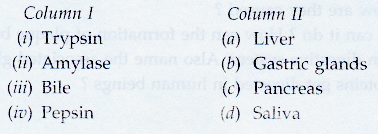
Solution :
(i) – (c)
(ii) – (d)
(iii) – (a)
(iv) – (b)
Lakhmir Singh Biology Class 10 Solutions Page No:26
Question 58:
(a) What is common for Cuscuta, ticks and leeches ?
(b) Name the substances on which the following enzymes act in the human digestive system :
(i) Trypsin
(ii) Amylase
(iii) Pepsin
(iv) Lipase
(c) Why does absorption of digested food occur mainly in the small intestine ?
Solution :
(a) Parasitic mode of nutrition.
(b)
(i) Proteins
(ii) Starch
(iii) Proteins
(iv) Fats.
(c) Absorption of digested foods occurs mainly in the small intestine due to the presence of a large number of finger like projections called villi.
Question 59:
(a) Why is small intestine in herbivores longer than in carnivores ?
(b) What will happen if mucus is not secreted by the gastric glands ?
(c) What causes movement of food inside the alimentary canal ?
Solution :
(a) Herbivores eat only plants so they need a longer small intestine to allow the cellulose present in the plants to be digested completely.
(b) If mucus is not secreted, hydrochloric acid will cause the erosion of inner lining of stomach leading to the formation of ulcers in the stomach.
(c) The contraction and expansion movements of oesophagus also called peristaltic movements pushes the food down into the elementary canal.
Question 60:
(a) How do guard cells regulate opening and closing of stomatal pores ?
(b) Two similar green plants are kept separately in oxygen free containers, one in dark and the other in continuous light. Which one will live longer ? Give reasons.
Solution :
(a) The opening and closing of stomatal pores is controlled by the guard cells, when water flows into the guard cells, they swell, become curved and cause the pore to open whereas when the guard cells lose water, they shrink, become straight and close the stomatal pore. (b) Plant kept in continuous light will live longer because it will be able to produce oxygen required for its respiration by the process of photosynthesis.
Question 61:
(a) What would happen if all the green plants disappear from the earth ?
(b) If a plant is releasing carbon dioxide and taking in oxygen during the day, does it mean that there is no photosynthesis occurring ? Justify your answer.
Solution :
(a) If all the green plants disappear from the earth, then all the organisms (herbivores, carnivores and omnivores) will die due to starvation as green plants are the source of food for all organisms.
(b) When photosynthesis occurs during the day, the carbon dioxide released by plants by respiration is all used up and not released. Similarly, some of the oxygen produced during photosynthesis is used up in respiration. Since the plant is releasing carbon dioxide and taking in oxygen even during the day, it means that no photosynthesis is taking place.
Question 62:
(a) Leaves of a healthy potted plant were coated with vaseline. Will this plant remain healthy for long ? Give reason for your answer.
(b) What will happen to the rate of photosynthesis in a plant under the following circumstances ?
- cloudy day in morning but bright sunshine in the afternoon
- no rainfall in the area for a considerable time.
- gathering of dust on the leaves
Solution :
(a) This plant will not remain healthy for long because vaseline coating closes the stomatal pores on the leaves due to which
(i) plant will not get oxygen for respiration
(ii) plant will not get carbon dioxide for photosynthesis, and
(iii) plant will not get water (and minerals) due to stoppage of transpiration.
(b) (i) Decreases in morning but increases in the afternoon
(ii) Decreases.
(iii) Decreases.
Question 63:
(a) What is photosynthesis ?
(b) Write a chemical equation to show the process of photosynthesis in plants.
(c) Explain the mechanism of photosynthesis.
Solution :
(a) The process by which green plants make their own food (like glucose) from carbon dioxide and water by using sunlight energy in the presence of chlorophyll is called photosynthesis.

(c) The process of photosynthesis takes place in the green leaves of a plant. The carbon dioxide gas required for making food is taken by the plant leaves from the air which enters the leaves through tiny pores called stomata. Water required for making food is taken from the soil which is transported to the leaves from the soil through the roots and the stem. The sunlight provides energy required to carry out the chemical reactions involved in the preparation of food. The green pigment called chlorophyll absorbs sunlight energy. The photosynthesis takes place in three steps:
(i) Absorption of sunlight energy by chlorophyll.
(ii) Conversion of light energy into chemical energy and splitting of water into hydrogen and oxygen by light energy.
(iii) Reduction of carbon dioxide by hydrogen to form carbohydrates like glucose by utilising the chemical energy.
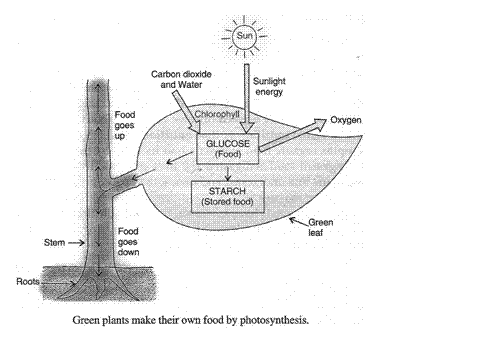
Question 64:
(a) Name the raw materials required for photosynthesis. How do plants obtain these raw materials ?
(b) What are the various conditions necessary for photosynthesis ?
(c) Name the various factors which affect the rate of photosynthesis in plants.
Solution :
(a) The raw materials for photosynthesis are carbon dioxide and water. The green plants take carbon dioxide from air for photosynthesis. The carbon dioxide gas enters the leaves of the plants through the stomata present on their surface. The water required by the plants for photosynthesis is absorbed by the roots of the plants from the soil through the process of osmosis. The water absorbed by the roots is transported upwards through the xylem vessels to the leaves where it reaches the photosynthetic cells and utilized in photosynthesis.
(b) The conditions for photosynthesis are sunlight, chlorophyll, carbon dioxide and water.
(c) Factors affecting the rate of photosynthesis are
(i) Light
(ii) Carbon dioxide
(iii) Water
(iv) Temperature
(v) Mineral elements.
Question 65:
(a) Define nutrition. Why is nutrition necessary for an organism ?
(b) What are the different modes of nutrition ? Explain with one example of each mode of nutrition.
(c) Name the mode of nutrition in
(i) roundworm, and
(ii) Plasmodium.
Solution :
(a) Nutrition is defined as a process of intake of nutrients (like carbohydrates, fats, proteins, minerals, vitamins and water) by an organism as well as the utilisation of these nutrients by the organism. Nutrition is necessary for an organism as it provides energy to them from the food they eat. (b) There are mainly two modes of nutrition:
(i) Autotrophic – Autotrophic nutrition is that mode of nutrition in which an organism makes its own food from the simple inorganic materials like carbon dioxide and water present in the surroundings (with the help of sunlight energy). Example: Green plants obtain food by autotrophic nutrition.
(ii) Heterotrophic – Heterotrophic nutrition is that mode of nutrition in which an organism cannot make its own food from simple inorganic materials like carbon dioxide and water, and depends on other organisms for its food. Example: All animals obtain food by heterotrophic nutrition.
(c) The mode of nutrition in
(i) round worm and
(ii) plasmodium is parasitic nutrition.
Question 66:
(a) What are herbivores, carnivores and omnivores ? Give two examples of each.
(b) Classify the following into herbivores, carnivores and omnivores :
Lion, Man, Dog, Goat, Crow, Elephant, Snake, Hawk, Rabbit, Deer
(c) Name the five steps which occur in the process of nutrition in animals.
Solution :
(a) (i) Herbivores – Those animals which eat only plants are called herbivores. Example: Goat and cow.
(ii) Carnivores – Those animals which eat only other animals as food are called carnivores. Example: Tiger and Lion.
(iii) Omnivores – Those animals which eat both plants and animals are called omnivores. Example: Human Being and dog.
(b)
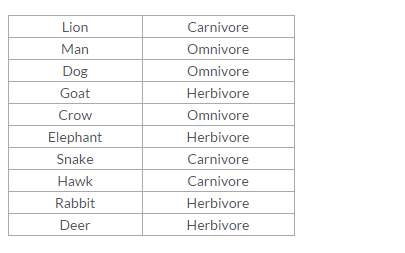
(c) The five steps involved in the process of nutrition in animals are
(i) Ingestion
(ii) Digestion
(iii) Absorption
(iv) Assimilation
(v) Egestion.
Question 67:
(a) Describe the process of nutrition in Draw labelled diagrams to show the various steps in the nutrition in Amoeba.
(b) What is the mode of nutrition in Amoeba known as ?
(c) What is the process of obtaining food by Amoeba called ? What does it mean ?
Solution :
(a) Nutrition in amoeba: Nutrition in amoeba involves the following steps
(i) Ingestion ? Amoeba has no mouth for ingestion of food. It ingests the food by using its pseudopodia. The food is engulfed with little water to form a food vacuole.
(ii) Digestion ? The food is digested by digestive enzymes present in the cytoplasm which breaks the food into small soluble molecules by chemical reactions.
(iii) Absorption ? The digested food is absorbed directly into the cytoplasm by diffusion. The digested food spreads out from the food vacuole into the whole cell and after absorption the food vacuole disappears.
(iv) Assimilation ? Food is used to obtain energy through respiration and the remaining part of the food is used for growth.
(v) Egestion ? The undigested food collects inside the cell and the cell membrane ruptures. Through this, the undigested food is thrown out of the body.
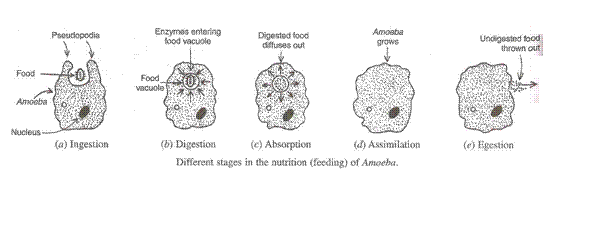
(b) The mode of nutrition in amoeba is holozoic.
(c) The process of obtaining food is called phagocytosis, which means cell feeding.
Question 68:
(a) Draw a labelled diagram of the human digestive system. With the help of this diagram, describe the process of digestion of food in man (humans).
(b) Describe one way in which the small intestine is adapted for the absorption of digested food.
(c) What is the special name of the contraction and expansion movement which pushes the food further in our digestive tract (or alimentary canal) ?
Solution :
(a) Digestion of food in human beings: Digestion of food begins in the mouth. The mouth cavity contains teeth, tongue and salivary glands. The teeth cut the food into small pieces, chew and grind it. This is called physical digestion. Salivary glands produce saliva which mixes with the food. This involves chemical digestion of food. The saliva contains an enzyme called salivary amylase which digests the starch and converts it into maltose sugar. Mouth opens into a small funnel shaped area called pharynx which leads to a long tube called oesophagus. It carries the food down into the stomach. The wall of oesophagus is muscular. When the slightly digested food enters the food pipe, the walls of the oesophagus starts contraction and expansion movements called peristaltic movements which push the food into the stomach. Digestion does not take place in the oesophagus. The glands present on the walls of the stomach secrete gastric juice that contains hydrochloric acid, the enzyme pepsin and mucus. A small amount of gastric lipase is also present that breaks down the fats present in the food. Gastric juice is acidic due to the presence of HCl which is necessary for the pepsin to become active and converts the proteins into peptones. The mucus protects the stomach walls from HCl. From the stomach, the partially digested food goes into the small intestine through sphincter muscle. Small intestine is divided into two parts: Duodenum and Ileum. Duodenum receives the secretions of two glands, liver and pancreas through a common duct. Liver secretes bile which is alkaline and contains salts to emulsify the fats (or lipids). The bile secreted by the liver is stored in the gall bladder. Pancreas secretes pancreatic juice which contains trypsin, lipase and pancreatic amylase. Trypsin digests the proteins, lipase emulsifies the fats and pancreatic amylase breaks down the starch. Thus, small intestine is the site of complete digestion of carbohydrates, proteins and fats. The walls of ileum secrete succus entericus which completes the digestion process.
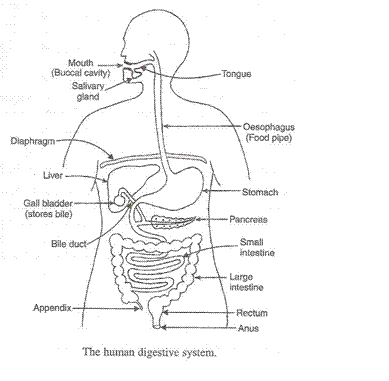
(b) The walls of small intestine has finger like projections like villi which increases the surface area for absorption.
(c) Peristaltic movements.
Question 69:
(a) Describe the parts of our tooth with the help of a labelled diagram.
(b) What is meant by dental caries ? How are they caused ?
(c) What is dental plaque ? What harm can it do ? How can the formation of plaque be prevented ?
Solution :
(a) The tooth has hard outer covering called enamel. The part of tooth below enamel is called dentine inside which is the pulp cavity. The pulp cavity contains nerves and blood vessels.
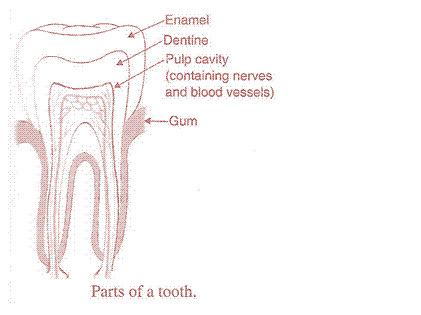
(b) The formation of small cavities (or holes) in the teeth due to the action of acid forming bacteria and improper dental care is called dental caries. This happens as follows: When we eat sugary food, the bacteria in our mouth act on sugar to produce acids. These acids dissolve the calcium salts from the tooth enamel and then from dentine forming small cavities in the tooth over a period of time in our mouth act on sugar to produce acids. These acids dissolve the calcium salts from the tooth enamel and then from dentine forming small cavities in the tooth over a period of time.
(c) If the teeth are not cleaned regularly, they become covered with the sticky, yellowish layer of food particles and bacteria cells called dental plaque. It causes tooth decay. It can be prevented by brushing the teeth regularly as it neutralises the acids.
Question 70:
(a) Name the main organs of the human digestive system. Also name the associated glands.
(b) How do carbohydrates, fats and proteins get digested in human beings ?
Solution :
(a) The various organs of the human digestive system are mouth, oesophagus, stomach, small intestine and large intestine. The glands associated with the human digestive system are salivary glands, liver and pancreas.
(b) (i) Carbohydrates – The digestion of carbohydrates begins in the mouth. The human saliva contains an enzyme called salivary amylase which digests the starch present in the food into maltose sugar. The slightly digested carbohydrates when reaches the small intestine, pancreatic amylase present in the pancreatic juice breaks down the starch. The intestinal juice of the small intestine completes the digestion of carbohydrates and finally coverts it into glucose.
(ii) Fats – The process of digestion of fats begins in the stomach. The glands of stomach secrete a small amount of gastric lipase that breaks down the fats present in the food. From the stomach the partially digested food goes into small intestine where the pancreatic lipase breaks down the emulsified fats. The walls of small intestine secrete intestinal juice which converts the fats into fatty acids and glycerol.
(iii) Proteins – The digestion of proteins begins in the stomach. The glands of the stomach secrete gastric juice which contains an enzyme called pepsin. Pepsin converts the proteins into peptones. Pancreatic juice contains trypsin which digests the proteins into peptides and the intestinal juice completes the process of digestion of proteins thus converting it into amino acids.
Lakhmir Singh Biology Class 10 Solutions Page No:46
Question 1:
Do all cells use oxygen to produce energy ?
Solution :
No.
Question 2:
Name one substance which is produced in anaerobic respiration by an organism but not in aerobic respiration.
Solution :
Ethanol.
Question 3:
Name one organism which can live without oxygen.
Solution :
Yeast can live without oxygen.
Question 4:
In which type of respiration, aerobic or anaerobic, more energy is released ?
Solution :
Aerobic respiration.
Question 5:
Name the substance whose build up in the muscles during vigorous physical exercise may cause cramps.
Solution :
Lactic acid.
Question 6:
Which part of roots is involved in the exchange of respiratory gases ?
Solution :
Root hairs.
Lakhmir Singh Biology Class 10 Solutions Page No:47
Question 7:
Name the process by which plant parts like roots, stems, and leaves get oxygen required for respiration.
Solution :
Diffusion.
Question 8:
Name the pores in a leaf through which respiratory exchange of gases takes place.
Solution :
Stomata.
Question 9:
Name the areas in a woody stem through which respiratory exchange of gases takes place.
Solution :
Lenticels.
Question 10:
What is the name of the extensions of the epidermal cells of a root which help in respiration ?
Solution :
Root hair.
Question 11:
Out of photosynthesis and respiration in plants, which process occurs :
(a) all the time ?
(b) only at daytime ?
Solution :
(a) Respiration.
(b) Photosynthesis.
Question 12:
Name the organs of breathing in fish.
Solution :
Gills.
Question 13:
Name an animal which absorbs oxygen through its moist skin.
Solution :
Earthworm.
Question 14:
Name an animal which depends on simple diffusion of gases for breathing.
Solution :
Amoeba.
Question 15:
Name two animals which breathe through gills.
Solution :
Prawns and mussels.
Question 16:
The trachea divides into two tubes at its lower end. What is the name of these tubes ?
Solution :
Bronchi.
Question 17:
Where does the blood absorb oxygen in the human body ?
Solution :
Alveoli.
Question 18:
Name the red pigment which carries oxygen in blood.
Solution :
Haemoglobin.
Question 19:
Which gases are exchanged in your lungs ?
Solution :
Oxygen and carbon dioxide.
Question 20:
Where in the lungs does gas exchange take place ?
Solution :
Alveoli.
Question 21:
What is the name of tiny air-sacs at the end of smallest bronchioles in the lungs ?
Solution :
Alveoli.
Question 22:
What is the other name of wind-pipe ?
Solution :
Trachea.
Question 23:
What organs are attached to the two bronchi ?
Solution :
Lungs.
Question 24:
In the lungs :
(a) what substance is taken into the body ?
(b) what substance is removed from the body ?
Solution :
(a) Oxygen.
(b) Carbon dioxide.
Question 25:
State whether the following statements are true or false :
(a) During respiration, the plants take C0
2
and release 0
2
.
(b) Energy can be produced in cells without oxygen.
(c) Fish and earthworm exchange gases during respiration in the same way.
Solution :
(a) False.
(b) True.
(c) False.
Question 26:
Fill in the following blanks with suitable words :
(a) The organs of respiration in man are the…………..
(b) The actual exchange of gases takes place in the………… of the lungs.
(c) ………………in the lungs provide a very large surface area for gaseous exchange.
(d) Yeast undergoes……….. respiration whereas Amoeba undergoes………….. respiration.
(e) Gills are the breathing organs in…………..
Solution :
(a) Lungs.
(b) Alveoli.
(c) Alveoli.
(d) Anaerobic, aerobic.
(e) Fish.
Question 27:
Explain why, a land plant may die if its roots remain water logged for a long time.
Solution :
A land plant may die if its roots remain water logged for a long time because too much water expels all the air from in-between the soil particles. Due to this, oxygen is not available to the roots for aerobic respiration. Under these conditions the roots will respire anaerobically producing alcohol which may kill the plant.
Question 28:
What are the differences between aerobic and anaerobic respiration ? Name some organisms that use anaerobic mode of respiration.
Solution :
(a)
Aerobic respiration
(i) Aerobic respiration takes place in the presence of oxygen.
(ii) Complete breakdown of food occurs in aerobic respiration.
(iii) The end products in aerobic respiratin are carbon dioxide and water.
(iv) Aerobic respiration produces a considerable amount of energy.
Anaerobic respiration
(i) Anaerobic respiration takes place in the absence of oxygen.
(ii) Partial break down of food occurs in anaerobic respiration.
(iii) The end products in anaerobic respiration are ethanol and carbon dioxide (in yeast) and lactic and (in animal muscles).
(iv) Much less energy is produced in anaerobic respiration.
(b) Yeast and some bacteria.
Question 29:
Name the final product/products obtained in the anaerobic respiration, if it takes place :
(a) in a plant (like yeast).
(b) in an animal tissue (like muscles).
Solution :
(a) Ethanol and carbon dioxide.(b) Lactic acid.
Question 30:
What type of respiration takes place in human muscles during vigorous physical exercise ? Give reason for your answer.
Solution :
Anaerobic respiration takes place in human muscles during vigorous physical exercise because oxygen gets used up faster in the muscle cells than can be supplied by the blood.
Question 31:
Name the type of respiration in which the end products are :
(a) C
2
H,OH and C0
2
(b) C0
2
and H
2
0
(c) Lactic acid
Give one example of each case where such a respiration can occur.
Solution :
(a) Anaerobic respiration in yeast.
(b) Aerobic respiration in humans.
(c) Anaerobic respiration in muscle tissue of animals.
Question 32:
Define breathing. State the differences between breathing and respiration.
Solution :
The mechanism by which an organism obtains oxygen from the air and releases carbon dioxide is called breathing.Difference between breathing and respiration:-
Breathing
(i) Breathing is a simple process.
(ii) Breathing involves taking in oxygen from the air and releasing carbon dioxide into the air.
(iii) Breathing is a physical process.
Respiration
(i) Respiration is a complex process.
(ii) Respiration includes breathing as well as the oxidation of food in the cells of the organism to release energy.
(iii) Respiration is a bio-chemical process.
Question 33:
What are the different ways in which glucose is oxidised to provide energy in various organisms ? Give one example of each.
Solution :
There are two ways in which glucose is oxidized to provide energy in various organisms:
(i) Anaerobic respiration ? The respiration which takes place without oxygen is called anaerobic respiration.Example: Yeast and some bacteria break down glucose into ethanol and carbon dioxide.
(ii) Aerobic respiration ? The respiration which uses oxygen is called aerobic respiration.Example: Plants and animals break down glucose completely into carbon dioxide and water to release energy.
Lakhmir Singh Biology Class 10 Solutions Page No:48
Question 34:
Explain why, when air is taken in and let out during breathing, the lungs always contain a residual volume of air.
Solution :
During the breathing cycle, when air is taken in and let out, the lungs always contain a certain residual volume of air so that there is sufficient time ‘for the oxygen absorbed’ into the blood and ‘for the carbon dioxide to be released’ from the blood.
Question 35:
Explain why, it is dangerous to inhale air containing carbon monoxide.
Solution :
It is dangerous to inhale air containing carbon monoxide as it binds very strongly with haemoglobin in the blood and prevents it from carrying oxygen to the brain and other parts of the body. Due to lack of oxygen, the person cannot breathe properly and may become unconscious or may even die.
Question 36:
Describe the process of respiration in State whether it is anaerobic respiration or aerobic respiration.
Solution :
(a) Respiration in amoeba: Amoeba depends on simple diffusion of gases for breathing. The diffusion of gases takes place through the thin cell membrane of amoeba. Amoeba lives in water which contains dissolved oxygen. The oxygen from water diffuses into the body of amoeba through its cell membrane. The oxygen spreads quickly into the whole body and is used for respiration inside the amoeba cell. The process of respiration produces carbon dioxide which diffuses out through its cell membrane into the surrounding water.
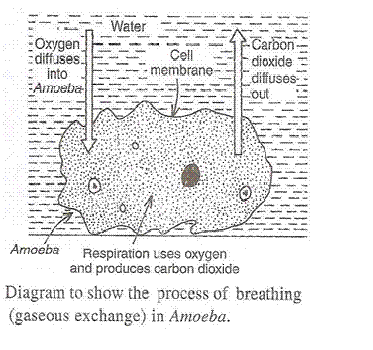
(b) It is aerobic respiration.
Question 37:
State the three common features of all the respiratory organs like skin, gills and lungs.
Solution :
The common features of all respiratory organs ? skin, gills and lungs are:
(i) All the respiratory organs have a large surface area to get enough oxygen.
(ii) All the respiratory organs have thin walls for easy diffusion and exchange of respiratory gases.
(iii) All the respiratory organs like skin, gills and lungs have a rich blood supply for transporting respiratory gases.
Question 38:
Describe the process of respiration in fish.
Solution :
Respiration and fish: The fish has special organ of breathing called gills on both the sides of its head. The gills are covered by gill covers. The fish lives in water which contains dissolved oxygen. The fish breathes by taking in water through its mouth and sending it over the gills. When water passes over the gills, the gills extract dissolved oxygen from the water. The extracted oxygen is absorbed by the blood and carried to all the parts of the fish. The carbon dioxide produced by respiration is brought back by the blood into the gills for expelling into the surrounding water.
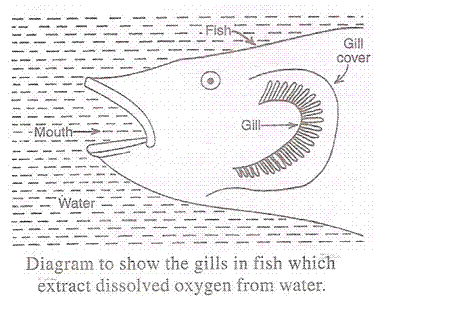
Question 39:
What would be the consequences of deficiency of haemoglobin in our bodies ?
Solution :
The deficiency of haemoglobin in the blood of a person reduces the oxygen carrying capacity of blood resulting in breathing problems, tiredness and lack of energy.
Question 40:
Describe the process of respiration in the following parts of a plant :
(a) Root
(b) Stem
(c) Leaves
Solution :
(a) Respiration in roots: The roots of a plant take the oxygen required for respiration from the air present in-between the soil particles by the process of diffusion. The roots have extensions of epidermal cells of a root called root hair which are in contact with the air in the soil. Oxygen diffuses from root hairs and reaches all the other cells of the root for respiration. Carbon dioxide gas produced in the cells of the root during respiration moves out through the root hairs by the process of diffusion. Thus, the respiration in roots occurs by diffusion of respiratory gases through the root hairs.
(b) Respiration in stems: The stems of herbaceous plants takes place through stomata. The oxygen from the air diffuses into the stem of a herbaceous plant through stomata and reaches all the cells for respiration. The carbon dioxide produced diffuses out through stomata. In woody stems, the bark has lenticels for the exchange of gases.
(c) Respiration in leaves: The leaves of a plant has tiny pores called stomata through which the exchange of respiratory gases takes place by diffusion. Oxygen from air diffuses into a leaf through stomata and reaches all the cells, where it is used for respiration and the carbon dioxide produced diffuses out from the leaf into the air through stomata.
Question 41:
(a) What is meant by aquatic animals and terrestrial animals ?
(b) From where do the aquatic animals and terrestrial animals obtain oxygen for breathing and respiration ?
Solution :
(a) Aquatic animals are the animals which live in water and the terrestrial animals are the animals which live on land.
(b) The aquatic animals use the oxygen dissolved in water to carry out respiration. The terrestrial animals obtain oxygen from air.
Question 42:
Why do fishes die when taken out of water ?
Solution :
Fishes die when taken out of water because they do not have lungs to utilize the oxygen of air for breathing and respiration. They have gills which can extract only dissolved oxygen from water.
Question 43:
Why is the rate of breathing in aquatic organisms much faster than in terrestrial organisms ?
Solution :
The rate of breathing in aquatic animals is much faster than terrestrial animals because the amount of oxygen dissolved in water is low as compared to the amount of oxygen dissolved in air.
Question 44:
Name the energy currency in the living organisms. When and where is it produced ?
Solution :
The energy currency of the cell is ‘ATP’. It is produced in cytoplasm in lower organisms which respire anaerobically. In higher organisms, ‘ATP’ is produced in mitochondria when they respire aerobically.
Question 45:
Explain why, plants have low energy needs as compared to animals.
Solution :
Plants do not move. In a large plant body there are many dead cells like sclerenchyma as a result it requires less energy as compared to animals.
Question 46:
Explain how, it would benefit deep sea divers if humans also had gills.
Solution :
If humans also had gills then the deep sea divers could remain under sea water even without carrying oxygen cylinders for breathing as they would be able to extract the dissolved oxygen from water for breathing purpose just like a fish does.
Question 47:
(a) What is the function of the respiratory system ?
(b) What are the major organs of respiratory system in man (or humans) ?
(c) Draw a labelled diagram of the human respiratory system.
Solution :
(a) The function of respiratory system is to breathe in oxygen for respiration (producing energy from food), and to breathe out carbon dioxide produced by respiration.
(b) The major organs of respiratory system in human beings are:
(i) Nose
(ii) Nasal Passage
(iii) Trachea
(iv) Bronchi
(v) Lungs and
(vi) diaphragm.
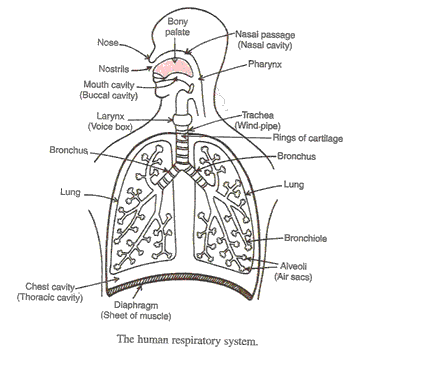
Question 48:
(a) Explain how, the air we breathe in gets cleaned while passing through the nasal passage.
(b) Why do the walls of trachea not collapse when there is less air in it ?
(c) How are oxygen and carbon dioxide exchanged in our body during respiration ?
(d) How are lungs designed in human beings to maximise the exchange of gases ?
Solution :
(a) When air passes through the nasal passage, the dust particles and other impurities present in it are trapped by nasal hair and mucus so that clean air goes into the lungs.
(b) Trachea does not collapse even when there is no air in it because it is supported by rings of soft bones called cartilage.
(c) During the process of ‘breathing in’ the air sacs or alveoli of the lungs get filled with air containing oxygen. The alveoli are surrounded by capillaries carrying blood so the oxygen of air diffuses from the alveoli walls into the blood from where it is carried to all the parts of the body.As the blood passes through the tissues of the body, the oxygen present in it diffuses into the cells. This oxygen combines with the digested food to release energy. Carbon dioxide gas is produced as a waste product during respiration in the cells of the body tissues which diffuses into the blood. Blood carries the carbon dioxide back to the lungs where it diffuses into the alveoli.
(d) The human lungs have been designed to maximise the exchange of gases as there are millions of alveoli in the lungs which provides a large surface area for the exchange of gases.
Question 49:
(a) Give the main points of difference between respiration in plants and respiration in animals.
(b) Describe the exchange of gases which takes place in the leaves of a plant (a) during daytime, and (b) at night.
(c) Which contains more carbon dixoide : exhaled air or inhaled air ? Why ?
Solution :
(a)
Respiration in plants
(i) All the parts of the plants perform respiration individually.
(ii) During respiration in plants there is a little transport of respiratory gases from one part of the plant to the other.
(iii) The respiration in plants occurs at a slow rate.
Respiration in Animals
(i) An animal perfomrs respiration as a single unit.
(ii) Respiratory gases are usually transported over long distances inside an animal during respiration.
(iii) The respiration in animals occurs at a much faster rate.
(b)
(i) During daytime when photosynthesis occurs, oxygen is produced. The leaves use some of this oxygen for respiration and the rest of oxygen diffuses out into the air. Carbon dioxide produced by respiration is all used up in photosynthesis by leaves during the daytime. Even more carbon dioxide is taken in from air. Thus, the net gas exchange in leaves during daytime is: Oxygen diffuses out; Carbon dioxide diffuses in.
(ii) At night time, when no photosynthesis occurs and hence no oxygen is produced, oxygen from air diffuses in leaves to carry out respiration. Carbon dioxide produced by respiration diffuses out into air. So, the net gas exchange in leaves at night is: Oxygen diffuses in; Carbon dioxide diffuses out.
(c) Exhaled air contains more carbon dioxide because during the respiration process when oxygen breaks down glucose, then a lot of carbon dioxide is produced hence the exhaled air has a higher proportion of the same.
Question 50:
(a) “Respiration is a vital function of the body”. Justify this statement.
(b) What is the main difference between aerobic respiration and anaerobic respiration ? Give one example of each.
(c) What type of repiration takes place (i) in yeast, and (ii) in humans ?
Solution :
(a) Respiration is a vital function of the body as it provides energy for carrying out all the life processes which are necessary to keep the organism alive.
(b)
Aerobic respiration
(i) Aerobic respiration takes place in the presence of oxygen.
(ii) Complete breakdown of food occurs in aerobic respiration.
(iii) The end products in aerobic respiration are carbon dioxide and water.
(iv) Aerobic respiration produces a considerable amount of energy.
Example: Human Beings.
Anaerobic respiration
(i) Anaerobic respiration takes place in the absence of oxygen.
(ii) Partial breakdown of food occurs in anaerobic respiration.
(iii) The end products in anaerobic respiration are ethanol and carbon dioxide (in yeast) and lactic acid (in animal muscles).
(iv) Much less energy is produced in anaerobic respiration. Example: Yeast.
(c)
(i) Anaerobic respiration.
(ii) Aerobic respiration.
Question 51:
(a) Why is diffusion insufficient to meet the oxygen requirements of large multicellular organisms like humans ?
(b) What type of arrangement exists in the bodies of large animals to meet their oxygen requirements adequately ?
(c) What advantage a terrestrial animal has over an aquatic animal with regard to obtaining oxygen for respiration ?
Solution :
(a) Diffusion is insufficient to meet the oxygen requirements of large multicellular organisms like humans because the volume of human body is so big that the oxygen cannot diffuse into all the cells of the human body quickly and oxygen will have to travel large distances to reach each and every cell of the body.
(b) Large organisms contain a respiratory pigment called haemoglobin which carries the oxygen from the lungs to all the body cells very efficiently.
(c) A terrestrial animal has an advantage over an aquatic animal in regard to obtaining oxygen for respiration that it is surrounded by an oxygen rich atmosphere from where it can take any amount of oxygen.
Lakhmir Singh Biology Class 10 Solutions Page No:72
Question 1:
What is the name of tissues which transport :
(a) food in a plant ?
(b) water and minerals in a plant ?
Solution :
(a) Phloem.
(b) Xylem.
Question 2:
What substance/substances are transported in plants by :
(a) xylem vessels and tracheids ?
(b) sieve tubes (or phloem) ?
Solution :
(a) Water.
(b) Food.
Question 3:
Which organ acts as a pump in the circulatory system ?
Solution :
Heart.
Question 4:
Veins and arteries carry blood. Which of these carry blood :
(a) away from the heart ?
(b) back to the heart ?
Solution :
(a) Arteries.
(b) Veins.
Question 5:
Where does blood absorb oxygen ?
Solution :
Capillaries.
Question 6:
What stops blood from flowing backwards through the heart ?
Solution :
Valves stop the blood from flowing backward through the heart.
Question 7:
Name (i) largest artery, and
(ii) largest vein, in our body.
Solution :
(i) The largest artery in the human body is ‘Aorta’.
(ii) The largest vein in the human body is ‘Vena Cava’.
Question 8:
What gaseous waste products are excreted by plants ?
Solution :
Carbon dioxide, water vapour and oxygen.
Question 9:
Where is the dirty blood in our body filtered ?
Solution :
Glomerulus present in kidneys.
Question 10:
Name the procedure used in the working of artificial kidney.
Solution :
Dialysis.
Question 11:
From the following terms, choose one term which includes the other four :
Plasma, Platelets, Blood, RBC, WBC
Solution :
Blood.
Question 12:
What are the components of the transport system in highly organised plants ?
Solution :
Xylem and phloem.
Question 13:
Out of xylem and phloem, which one carries materials :
(a) upwards as well as downwards ?
(b) only upwards ?
Solution :
(a) Phloem.(b) Xylem.
Lakhmir Singh Biology Class 10 Solutions Page No:73
Question 14:
Name two liquids which help in the transport of substances in the human body.
Solution :
Blood and lymph.
Question 15:
What is the other name of main vein ?
Solution :
Vena Cava.
Question 16:
Name the conducting tissue of plants which is made of sieve tubes alongwith companion cells.
Solution :
Phloem.
Question 17:
Name the conducting tissue in plants which is made of
(a) living cells, and
(b) dead cells.
Solution :
(a) Phloem.
(b) Xylem.
Question 18:
State the term used for the transport of food from leaves to other parts of plant.
Solution :
Translocation.
Question 19:
Which process in a plant is accomplished by utilising energy from ATP : transport of water and minerals or transport of food ?
Solution :
Transport of food.
Question 20:
Name the two types of transport systems in the human beings.
Solution :
Blood circulatory system and lymphatic system.
Question 21:
Name a waste gas released by the plants
(a) only during the day time, and
(b) only during the night time.
Solution :
(a) Oxygen.
(b) Carbon dioxide.
Question 22:
Name one animal having single circulation of blood and another having double circulation.
Solution :
A fish has single circulation of blood and a frog has double circulation of blood.
Question 23:
State whether the following statements are true or false :
(a) Some organisms store wastes in body parts.
(b) The value of systolic pressure is always lower than that of diastolic pressure.
Solution :
(a) True.
(b) False.
Question 24:
Name the two parts of a plant through which its gaseous waste products are released into the air.
Solution :
Stomata in the leaves and lenticels in the stems are two parts through which a plant releases its gaseous waste products into the air.
Question 25:
What happens to the glucose which enters the nephron tubule alongwith the filtrate ?
Solution :
Glucose passes through the glomerulus alongwith the filtrate and gets collected in the Bowman’s capsule.
Question 26:
Name the two waste products of the human body which are produced in the body cells.
Solution :
Carbon dioxide and urea.
Question 27:
What is the role of glomerulus in the kidney ?
Solution :
The function of glomerulus is to filter the blood passing through it and initiate urine formation.
Question 28:
What is the the other name of ‘high blood pressure’ ?
Solution :
Hypertension.
Question 29:
Fill in the following blanks with suitable words :
(a) Gums and resins are the………….. products of plants.
(b) Bowman’s capsule and tubule taken together make a…………….
(c) The organs which extract the nitrogenous wastes from the blood are……………….
(d) The extracellular fluid which always flows from body tissues to the heart is called…………………
(e) The………… blood cells make antibodies whereas…………… blood cells help in respiration.
Solution :
(a) Waste.
(b) Nephron.
(c) Kidneys.
(d) Lymph.
(e) White, red.
Question 30:
What is xylem tissue ? Name the two kinds of cells in xylem tissue. State whether these cells are living or dead.
Solution :
Xylem tissue is a vascular tissue in plants which carries water and minerals from the roots to the various of the plant. Xylem tissue has two types of cells ? Xylem vessels and tracheids. Both these tissues are dead cells.
Question 31:
What is phloem tissue ? Phloem contains two types of cells joined side by side. Name these two types of cells. State whether these cells are living or dead.
Solution :
Phloem tissue is a vascular tissue which transports the food materials made in the leaves to the other parts of the plant. Phloem is made up of many cells joined end to end to form long tubes. The cells of the phloem are sieve tubes and companion cell. These are living cells.
Question 32:
(a) What is transpiration ?
What do you mean by ‘translocation’ with respect to transport in plants ?
Which plant tissue is involved in translocation : xylem or phloem ?
Solution :
(a) The evaporation of water from the leaves of the plants is called transpiration.
(b) The transport of food from the leaves to the other parts of the plant is called translocation.
(c) Phloem.
Question 33:
(a) Draw a labelled diagram of
(i) a xylem vessel, and
(ii) a sieve tube (or phloem).
(b) What are the differences between the transport of materials in xylem and phloem ?
Solution :
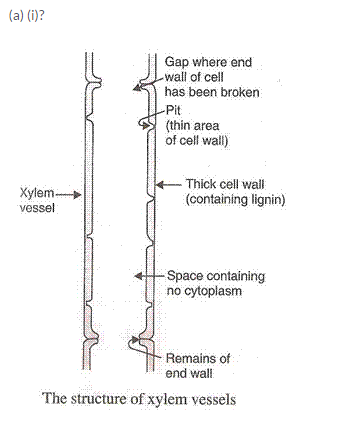
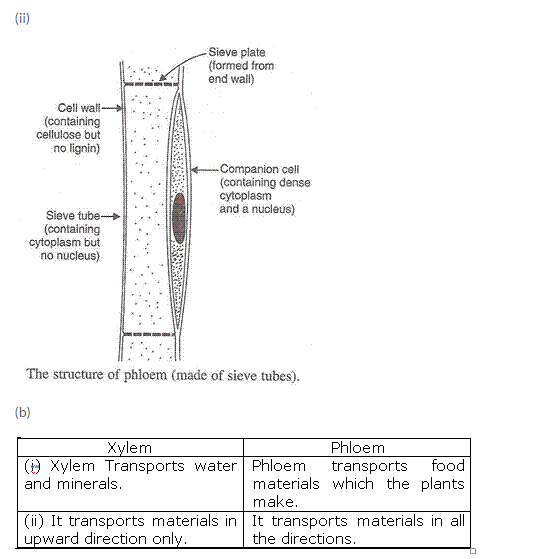
Question 34:
Match the terms in column I with their uses in column II

Solution :
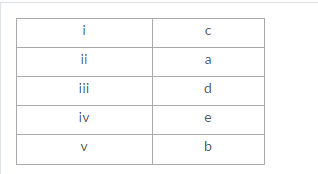
Question 35:
Define excretion. Name the excretory unit of a kidney.
Solution :
The process of removal of toxic waste from the body of an organism is called excretion. The excretory unit of a kidney is called nephron.
Question 36:
(a) What job is done by the kidneys ?
(b) What do kidneys excrete ?
(c) What is the name of the tubes which connect the kidneys to bladder ?
(d) What does the bladder in our body do ?
Solution :
(a) The kidneys remove the poisonous substance urea, other waste salts and excess water from the blood in the form of yellowish liquid called urine.
(b) Urea.
(c) Ureters.
(d) Urinary bladder is a bag which stores the urine temporarily till it is excreted out.
Question 37:
Why do some people need to use a dialysis machine ? What does the machine do ?
Solution :
When there is a kidney failure then dialysis machine is used. Dialysis cleans the blood of a person by separating the waste substance (urea) from the blood.
Question 38:
What is the liquid part of the blood called ? What is the function of platelets in the blood ?
Solution :
The liquid part of the blood is called plasma. Platelets help in the coagulation of blood in a cut or wound.
Lakhmir Singh Biology Class 10 Solutions Page No:74
Question 39:
(a) How many types of blood vessels are there in the human body ? Name them.
(b) Why does the heart need valves ?
Solution :
(a) There are three types of blood vessels – arteries, veins and capillaries.(b) Heart needs valves to prevent the backflow of blood so that the blood flows only in one direction.
Question 40:
A dialysis machine contains long tubes coiled in a tank containing dialysing solution :
(i) Of what substance are the tubes made ?
(ii) What does the dialysing solution contain ?
(iii) Name the main waste which passes into the dialysing solution.
Solution :
(i) Cellulose.
(ii) Water, glucose, salts in similar concentration to those in normal blood.
(iii) Urea.
Question 41:
State the differences between artery, vein and capillary.
Solution :
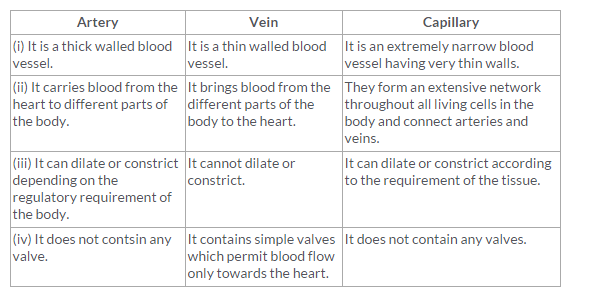
Question 42:
(a) What are the upper parts of the heart called ?
(b) What are the lower parts of the heart called ?
(c) What is the name of blood vessels which connect arteries to veins ?
(d)
(i) Which side of the heart pumps blood into the lungs ? .
(ii) Which side of the heart pumps blood into entire body (except the lungs) ?
Solution :
(a) Atria
(b) Ventricles
(c) Capillaries
(d)
(i) Right side
(ii) Left side
Question 43:
(a) What are the methods used by plants to get rid of their waste products ?
(b) How are waste products excreted in Amoeba ?
Solution :
(a) Thevarious methods used by the plants to get rid of their waste products are
(i) the plants get rid of gaseous waste products through stomata in leaves and lenticels in stems.
(ii) They get rid of solid and liquid waste by shedding off leaves, peeling of bark and falling of fruits.
(iii) Secreting gums and resins.
(iv) Plants excrete some waste substances into the soil around them.
(b) Excretion in amoeba: In amoeba, the waste material carbon dioxide is removed by diffusion through the cell membrane, but nitrogenous waste and excess water are removed by contractile vacuole.
Question 44:
(a) What is lymph ? State two major functions of lymph.
(b) What is meant by saying that the blood pressure of a person is 120/80 ?
Solution :
(a) Lymph is a light yellow liquid. It is a medium of circulation in human body which flows only in one direction – from body tissues to the heart. The functions of lymph are:
(i) It takes part in the nutritive process of the body.
(ii) It protects the body by killing the germs drained out of the body tissues with the help of lymphocytes contained in the lymph nodes, by making antibodies.
(iii) It helps in removing the waste products like fragments of dead cells etc.
(b) If the blood pressure of a person is 120/80 it means that the systolic pressure is 120 mm Hg and diastolic pressure is 80 mm Hg.
Question 45:
What is hypertension ? Why is it caused ? What harm can it do ?
Solution :
High blood pressure is called hypertension. It is caused by the constriction of very small arteries which results in increased resistance to blood flow. Very high blood pressure can lead to rupture of artery and internal bleeding.
Question 46:
What are the various components of blood ? State their functions.
Solution :
The main components of blood are:
(i) Plasma: It carries all the dissolved substances such as proteins, digested food, common salt etc from one part to another part of the body.
(ii) Red blood corpuscles (RBC): It carries oxygen from the lungs to all the cells of the body.
(iii) White blood corpuscles (WBC): It fights infection and protects us from diseases.
(iv) Platelets: It helps in the coagulation of blood in a cut or wound.
Question 47:
With which human organ systems (or human systems) are the following associated ?
(i) vena cava
(ii) glomerulus
(iii) alveoli
(iv) villi
Solution :
(i) Circulatory system.
(ii) Excretory system.
(iii) Respiratory system.
(iv) Digestive system.
Question 48:
What is meant by ‘systolic pressure’ and ‘diastolic pressure’ ? What are their normal values ?
Solution :
The maximum pressure at which the blood leaves the heart through the main artery (Aorta) during contraction phase is called systolic pressure. The minimum pressure in the arteries during relaxation phase of the heart is called the diastolic pressure. The normal blood pressure values are: Systolic pressure: 120 mm Hg. Diastolic pressure: 80 mm Hg.
Question 49:
(a) What is meant by ‘heart beat’ ? What is the usual heart beat rate at rest ?
(b) What change occurs in heart beats if a person runs for a while ? Why ?
Solution :
(a) Heart beat: One complete contraction and relaxation of the heart is called a heart beat. The usual heart beat rate at rest is 72 times /minute.
(b) The heart beats faster when a person runs for a while because the body needs more energy under these conditions.
Question 50:
(a) What is blood ? Why is it red ?
State the functions of blood in our body.
Name a circulatory fluid in the human body other than blood.
Solution :
(a) Blood is a red coloured liquid which circulates in our body. It is red because it contains a pigment called haemoglobin in its red cells.
(b) Functions of blood:
(i) It carries oxygen from the lungs to different parts of the body.
(ii) It carries carbon dioxide from the body cells to the lungs for breathing out.
(iii) It carries digested food from the small intestine to all the parts of the body.
(iv) It carries waste product called urea from the liver to the kidneys for excretion in the form of urine.
(v) It protects the body from diseases.(c) Lymph.
Question 51:
(a) What is meant by human circulatory system ? Name the organs of the circulatory system in humans.
Draw a diagram of the human heart and label its parts.
What is meant by the terms ‘single circulation’ and ‘double circulation’ ?
Solution :
(a) Human circulatory system is a system which is responsible for the transport of materials inside the body. The various organs of the circulatory system in humans are: heart, arteries, veins and capillaries.
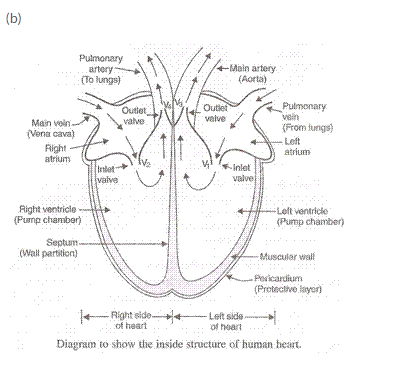
(c) Single circulation is a type of circulatory system in which the blood passes through the heart only once in one complete cycle of the body.Double circulation is a circulatory system in which the blood travels twice through the heart in one complete cycle of the body.
Question 52:
Describe the working of human blood circulatory system with the help of a suitable diagram which shows all the steps involved.
Solution :
Working of Human blood circulatory system takes place in the steps below:
(i) When the muscles of all the four chambers are relaxed, the pulmonary vein brings the oxygenated blood from the lungs in the left atrium of the heart.
(ii) When the left atrium contracts, the oxygenated blood is pushed into the left ventricle through valve V
1
.
(iii) When the left ventricle contracts, the oxygenated blood enters the main artery called aorta from which it goes to the different body organs through small branches called arterioles and capillaries. (iv) The main artery carries the blood to all the organs of the body head, arms etc except the lungs. The oxygenated blood gives off oxygen, digested food and dissolved materials to the body cells. The carbon dioxide produced in the cells enters the blood. The deoxygenated blood enters main vein called vena cava which carried it to the right atrium of the heart.
(v) When the right atrium contracts, the deoxygenated blood enters right ventricle through valve V
2
.
(vi) When the right ventricle contracts, the deoxygenated blood enters the lungs through pulmonary artery and releases carbon dioxide and absorbs fresh oxygen from air. The blood becomes oxygenated again and is sent to the left atrium of heart by pulmonary vein for circulation in the body. This whole process is repeated continuously.
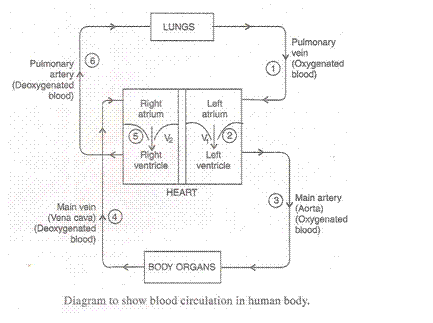
Question 53:
(a) Name the red pigment which carries oxygen in the blood.
(b) Why is it necessary to separate oxygenated and deoxygenated blood in mammals and birds ?
(c) How many chambers are there in the heart of :
(i) an amphibian,
(ii) a mammal, and
(iii) a fish ?
(d) Describe the circulatory system in a fish.
Solution :
(a) Haemoglobin.
(b) It is necessary to separate the oxygenated blood from mixing with deoxygenated blood as mammals and birds have high energy needs because they constantly require energy to maintain their body temperature.
(c)
(i) Three chambered heart.
(ii) Four chambered heart.(iii) Two chambered heart.
(d) The fish has a two chambered heart. Oxygenation of the blood takes place in the gills. The oxygenated blood from the gills is supplied to the body parts of the fish where oxygen is utilized and carbon dioxide enters into it making it deoxygenated. The deoxygenated blood returns to the heart to be pumped into gills again.
Question 54:
(a) What is lymphatic system ? What are its functions ?
(b) What is blood pressure ? What are the two factors used to express the blood pressure of a person ?
(c) Name the main nitrogenous waste in the human blood. How is it removed from the blood ?
Solution :
(a) Lymphatic system: A system of tiny tubes called lymph vessels (lymphatics) and lymph nodes (lymph glands) in the human body which transports the liquid called lymph from the body tissues to the blood circulatory system is called lymphatic system. Functions of lymphatic system:
(i) It takes part in the nutritive process of the body.
(ii) It protects the body by killing the germs drained out of the body tissues with the help of lymphocytes contained in the lymph nodes, by making antibodies.
(iii) It helps in removing the waste products like fragments of dead cells etc.
(b) Blood pressure: The pressure at which the blood is pumped around the body by the heart is called blood pressure. The two factors which expresses the blood pressure a person are systolic pressure and diastolic pressure.
(c) Urea is the main nitrogenous waste in human blood. It is removed from the body in the form of urine through the kidneys.
Question 55:
(a) Name the various organs of the human excretory system.
(b) Draw a neat labelled diagram of the human excretory system.
(c) What is the function of excretory system in humans ?
Solution :
(a) The excretory system of human beings consists of the following main organs: two kidneys, two ureters, bladder and urethra.
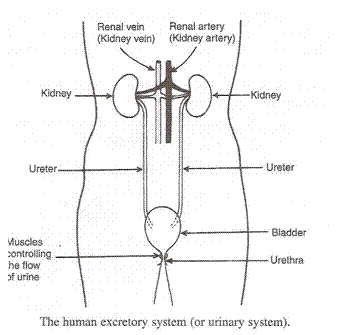
(c) The excretory system removes the poisonous waste substances from the body in the form of urine and maintains ionic balance called osmoregulation.
Question 56:
(a) Describe the mechanism of urine formation in human excretory system. Draw a labelled diagram to illustrate your answer.
(b) Where is urine carried through ureters ?
(c) What is urethra ?
Solution :
(a) Urine formation: The dirty blood containing waste like urea enters the glomerulus which filters the blood. During filtration, the substance like glucose, amino acids, salts, water, urea etc present in the blood pass into Bowman’s capsule and then enter the tubule of nephron. When the filtrate containing useful substances as well as the waste substances passes through the tubule, the useful substances like glucose, amino acids, most salts and water are reabsorbed into the blood through blood capillaries surrounding the tubule. Only the waste substances like urea, some unwanted salts and excess water remains behind in the tubule. This yellowish liquid is called urine.
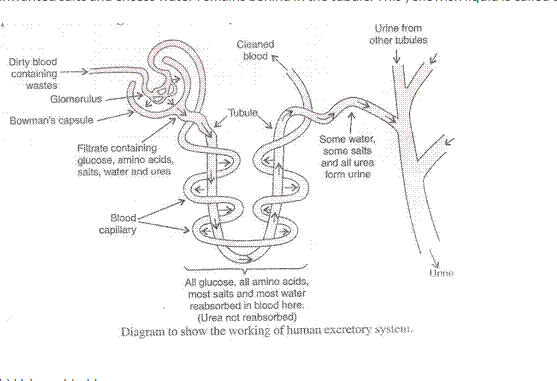
(b) Urinary bladder.
(c) Urethra is a tube which passes out the urine from the body collected in the urinary bladder.
Question 57:
(a) What is meant by dialysis ? What type of patients are put on dialysis ?
(b) Explain the principle of dialysis with the help of a labelled diagram.
Solution :
(a) Dialysis: The procedure used for cleaning the blood of a person by separating the urea from it is called dialysis. The patients with kidney failure are put on dialysis. (b) Principle of Dialysis: The blood from an artery in the patients arm is made to flow into the dialyser of a dialysis machine made of long tubes of selective permeable membrane (like cellulose) which are coiled in a tank containing dialysing
Solution. The dialysing
Solution contains water, glucose and salts in similar concentrations to those in normal blood. As the patient’s blood passes through the dialysing
Solution most of the waste like urea present in it pass through the selectively permeable cellulose tubes into the dialysing Solution. The clean blood is pumped back into a vein of the patients arm.
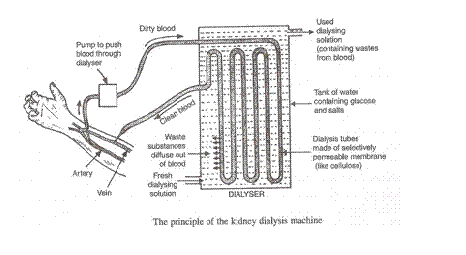
Question 58:
(a) Why is transport of materials necessary in an organism (plant or animal) ?
(b) What is the need of special tissues or organs for transport of substances in plants and animals ?
(c) How are water and minerals transported in plants ?
(d) How is food transported in plants ?
Solution :
(a) Transport in organisms (plants and animals) is necessary as it absorbs all essential substances and transports them to all parts so that they reach each and every cell of the body.
(b) Special tissues and organs are needed for the transport of substances in plants and animals because these tissues and organs can pick up the essential substances like food, oxygen, water, etc at one end of their body and carry them to all other parts.
(c) Water and minerals are transported to various parts of the plant by xylem tissues called xylem vessels and tracheids. Plants take in water from the soil through the roots. The water containing minerals called cell sap is carried by the xylem vessels to all the parts of the body. The roots have root hairs to absorb water and minerals from the soil by diffusion and then pass from cell to cell by osmosis through epidermis, root cortex, endodermis and then reach the root xylem. The water enters the root xylem into the stem xylem and then reaches the leaves from the petioles.
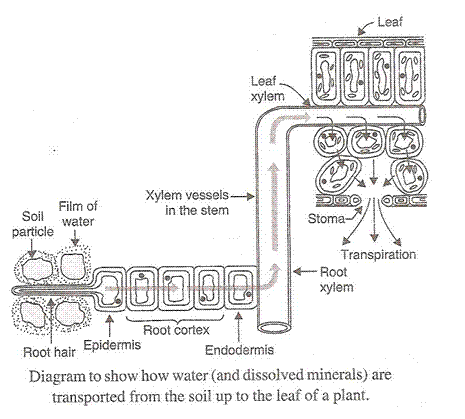
(d) Transportation of food in plants: The transport of food from the leaves to other parts of the plant is called translocation. Phloem tissue transports the food from the leaves to the other parts of the plant. The movement of food in phloem takes place by utilising energy. The sugar made in the leaves is loaded into the sieve tubes of phloem by using ATP. Water enters the sieve tube containing sugar which causes high pressure and pushes the food to all the parts of the plant having low pressure. This is how the food is transported according to the needs of the plant.